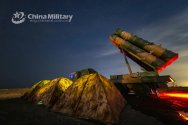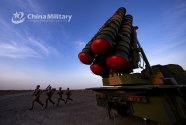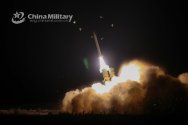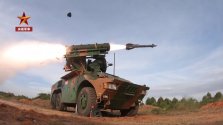If it's 30000 TRM in x-band then what must be the beam width.I was one of those who think HQ-9B would retain the old configurations namely PESA array. But this image changed my mind in instant. It's a legit AESA engagement Radar. So i stand corrected.
View attachment 113492
Notice the lack of Feed shroud on the back of the antenna cab. This was present on older HQ-9 engagement radar. Circled in red.
View attachment 113493
In place of the feed shroud there is a small cabin which i think the cooler which provide the air conditioning for the electronics and the TRM's inside antenna.
View attachment 113494
Some speculations i did, is the Radar would likely to have some 10000 TRM's but this is my assumption based on older HQ-9 which have Type-305 Early warning radar as organic part which signify that the radar is more specialized fire control radar. If it works as fire control, the antenna beamwidth must be about 1 Degrees, the number of TRM can then be determined as 10000 using simple equations one can find in "radar handbook 3rd edition" and the frequency is about 7 GHz the lower end of the C-band. The power can then be gleaned from the methods of cooling.
Oh and source, well i found this interesing Chinese channel which specifically talks about HQ-9B engagement radar.
Too bad i cant speak mandarin. Nonetheless the presenter of the show seems to work on some TRM's under the microscope.
You are using an out of date browser. It may not display this or other websites correctly.
You should upgrade or use an alternative browser.
You should upgrade or use an alternative browser.
PLA Anti-Air Missile (SAM) systems
- Thread starter FORBIN
- Start date
Such a high term count should be impossible without GaN.C-Band 10000 TRM is very significant, especially if it is GaN. That is 14 times the collection area, 10 times the power and 6 times the gain compared to a 5th gen fighter's radar. That is 5.3 times the range against targets of the same RCS. The tracking range against stealth aircraft should be over 120 km even head-on.
I was one of those who think HQ-9B would retain the old configurations namely PESA array. But this image changed my mind in instant. It's a legit AESA engagement Radar. So i stand corrected.
View attachment 113492
Notice the lack of Feed shroud on the back of the antenna cab. This was present on older HQ-9 engagement radar. Circled in red.
View attachment 113493
In place of the feed shroud there is a small cabin which i think the cooler which provide the air conditioning for the electronics and the TRM's inside antenna.
View attachment 113494
Some speculations i did, is the Radar would likely to have some 10000 TRM's but this is my assumption based on older HQ-9 which have Type-305 Early warning radar as organic part which signify that the radar is more specialized fire control radar. If it works as fire control, the antenna beamwidth must be about 1 Degrees, the number of TRM can then be determined as 10000 using simple equations one can find in "radar handbook 3rd edition" and the frequency is about 7 GHz the lower end of the C-band. The power can then be gleaned from the methods of cooling.
Oh and source, well i found this interesing Chinese channel which specifically talks about HQ-9B engagement radar.
Too bad i cant speak mandarin. Nonetheless the presenter of the show seems to work on some TRM's under the microscope.

Isn't this the HQ-9B FCR?
No, like TRM dimension is determined by the operational wavelength which then determines element spacing. The key dimension of TRM are its width which about half wavelength of the operating band. say you operate in C-band of some 6 GHz. your TRM would have about 2.7 cm of width. This would yield the element area of .00072 sqm.Such a high term count should be impossible without GaN.
If you have 3 x 3 meters antenna with total area of 9 sqm.. you can fit 9/0.00072 = 12535 TRM
The other thing determine the amount of TRM necessary would be the scan angle, the above calculations and my previous calculations assumes 60 degrees of scan angle (make it total 120 degrees of arc). If you can allow less scanning angle. you can reduce the amount of TRM you need and thus make the radar cheaper.
Isn't this the HQ-9B FCR?
and what is the source if this image ? like what show ?
Also the radar looks very different to what is shown in the CCTV vid i showed.
If it's 30000 TRM in x-band then what must be the beam width.
If you assume half wavelength spacing of the TRM's and axisymmetric array then the beamwidth can be found with simple equation of 100/SQRT(N) Where N is the TRM numbers while the resulted beamwidth has degrees unit. It would give you 0.58 Degrees.




